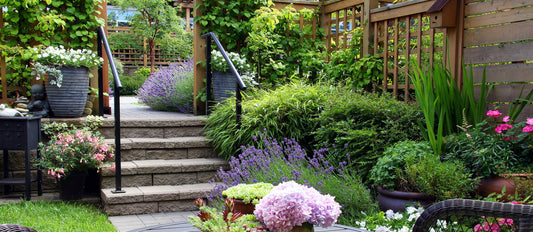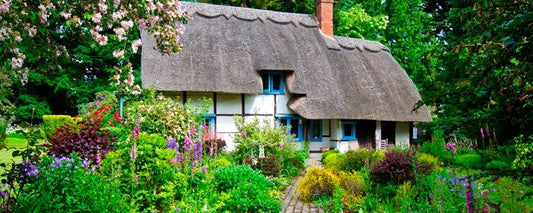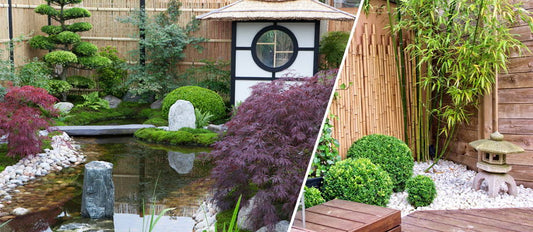Having a pond in your garden creates the ultimate summery feeling, with the water setting the scene for you to relax outdoors. But why stop there? If you'd like to turn your pond into a real aquatic oasis, then pond plants are perfect for you. As well as being attractive in their own right, they are also good for the creatures in the pond, like frogs, who shelter in the cooling shadows. Before you start adding plants from our range to brighten up your pond, it's best to know which ones are available and how to plant them. We tell you everything you need to know about these aquatic beauties.
Different types of pond plants
With pond plants, the different plants are divided into zones that depend on the planting depth beneath the water's surface. Each zone is matched to a plant type and these can all be found in our range of pond plants.
Zone 1: Waterside plants
As their name suggests, waterside plants are actually garden plants that are planted along the edge of the pond. Although they can be planted in both dry earth and damp soil, generally speaking, these plants should never be completely submerged in water. The only time that waterside plants can be partially underwater is after a heavy rainstorm, if the water in the pond has overflowed somewhat. So waterside plants need full soil and you can use potting soil for garden plants for this. For new ponds, we recommend adding a pond substrate and water-purifying bacteria to the water, as this helps keep the water environment in the pond stable. Nutrient-rich and oxygen-rich pond water will reach the roots of the waterside plants more easily and ensure stronger growth and better flowers. Finally, we cover the pond's bottom with gravel to stop the soil being washed away.
Zone 2: Marsh plants
Marsh plants are often planted within the margin of the pond, at a depth of between 0 cm and 15 cm. There are a number of types of marsh plant; some can grow in dry ground, some need to be sited in shallow water, and some can thrive in both dry locations and in water. Read the information on the packaging before planting, as it always states the recommended depth for planting. When planting, keep the marsh plant's root ball wet and set it in a special pond basket. You can put more than one plant in a pond basket, until it is full, then fill the spaces in between the plants with pond soil. Put a layer of coarse sand on top of the pond soil, to ensure it isn't washed away.
Some marsh plants grow very quickly and you can prune them to prevent the plant becoming too tall. It is also important to clip the withered parts of the plant off in the autumn. You should feed these marsh plants once a year, during the growing and flowering period.
Zone 3: Water plants
Water plants are perfect for the deeper parts of the pond and can be placed at depths of around 40 cm. Their roots must be completely under water and the plant itself can also survive when fully submerged. They love full sun and still water. You can also put water plants in the pond baskets; fill the basket with pond soil and a layer of coarse sand before positioning it in the water.
Zone 4: Water lilies
Water lilies are also known as the 'queen of the pond'. They are planted at a depth of between 40 cm and 120 cm, ideally between April and June. The planting method is the same as with water plants; place the bulb of the water lily in a pond basket and fill it with pond soil. The pond basket can be larger than those used for water plants, as water lilies do better when they have more room to grow. Then cover the soil with a layer of coarse sand to protect it from washing away. In a natural pond, you can plant water lilies directly in the bottom of the pond. Trim off the older leaves in the summer and especially if their leaves are covering too much of the water's surface, as this will stop the water from being properly oxygenated.
Zone 5: Oxygenating aquatic plants
As oxygenating aquatic plants are placed at about the same depth as water lilies, they are sometimes listed as zone 4 plants, together with water lilies. The difference is that oxygenating aquatic plants always grow under water. These plants are very important for water quality; keeping the water clear and free of algae, and converting nutrients in the water into oxygen. For them to grow well, oxygenating aquatic plants need for there to be enough food and CO2 in the water. We recommend introducing oxygenating aquatic plants when you establish your pond, to stop algae from forming. The exception to this is in winter, when the plants and algae do not grow. The best time to plant is between April and June. Oxygenating aquatic plants are also placed in pond baskets.
Zone 6: Floating plants
The name gives it away; unlike other pond plants, these ones float on the water and aren't planted underneath it. Simply place floating plants on the water's surface and they will form roots to take nutrients out of the water. Most floating plants will not tether themselves with their roots. Just like oxygenating aquatic plants, floating plants are a natural remedy against algae by removing salt from the water, so algae has more difficulty getting settled. Floating plants can self-seed quickly, which means that they can fill up the pond. To make sure that the pond gets enough light, we recommend removing some of the floating plants from the water a few times a year.
If you want to discover all these pond plants and order the most gorgeous ones for your garden, then browse our range now.




